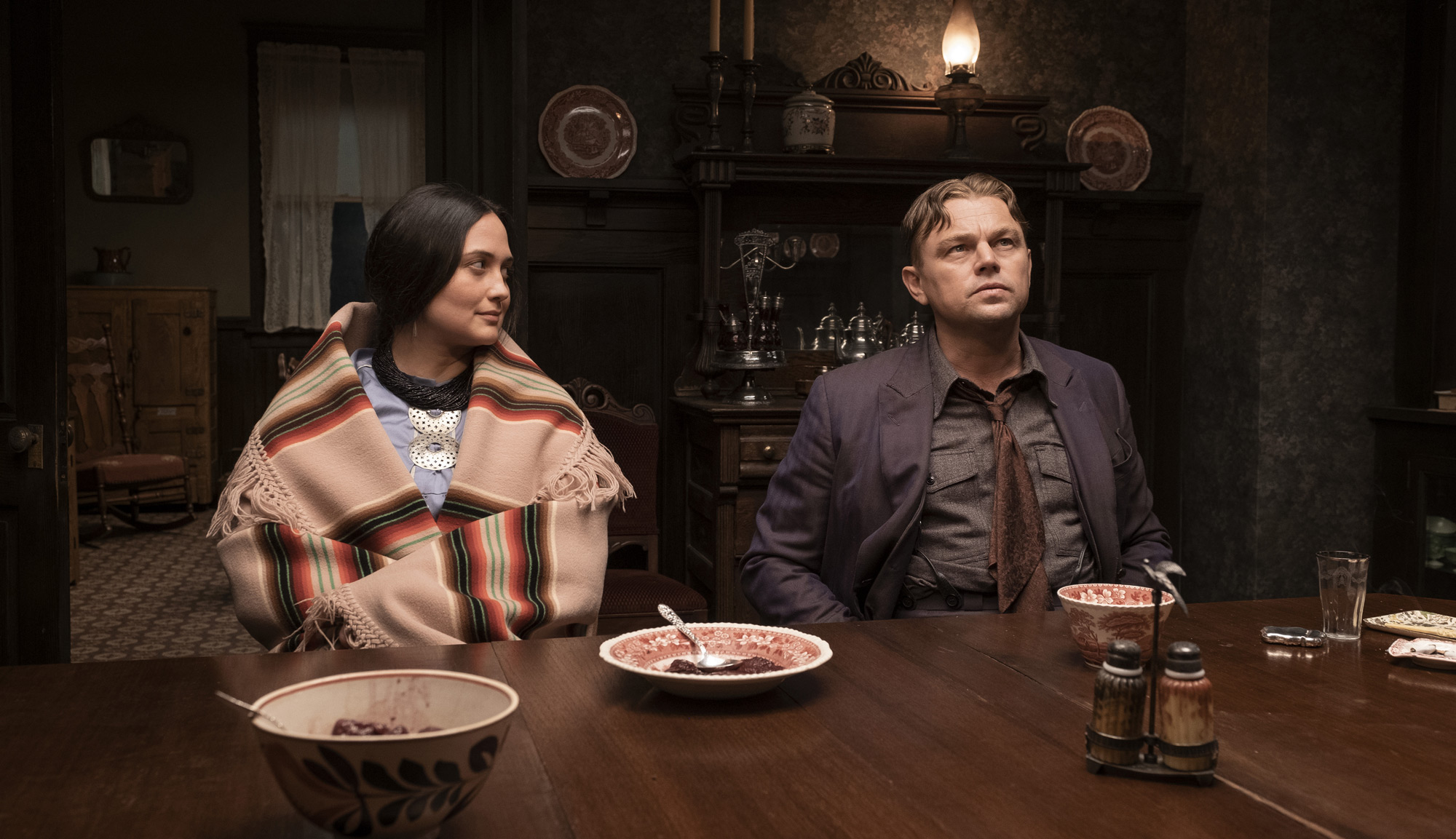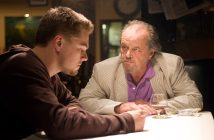
The story of America is a story of greed. In its best form, striving to attain more is the tell-tale sign of ambition, often sold as part of the American dream. At its worst, and most common, it is those in power coalescing more power through any means necessary, usually at the expense of the poor and already oppressed. “Killers of the Flower Moon” proves once again that there is no better artist who understands the complex rot at the heart of America than Martin Scorsese. With his latest film, the director (who also co-wrote with Eric Roth, adapted from the book by David Grann) has created an achingly beautiful tragedy that speaks to the venality of power while putting faces on a lesser-known (but horrifically prevalent and familiar) tale. “Killers of the Flower Moon” encompasses a vast spectrum of emotions that is impactful for how grounded it is in humanity, especially the worst of it.
Ernest Burkhart (Leonardo DiCaprio) returns from World War I seeking out his prosperous uncle, William “King” Hale (Robert De Niro). King has a cattle ranch in Osage, a land brimming with rich Native Americans who have an abundance of wealth thanks to finding oil. Ernest professes multiple times that he loves money, which fits in with King’s own designs, even though it is hidden behind a façade of geniality and support of the Osage tribe. Ernest weds Mollie (Lily Gladstone), a wealthy Osage who stands to inherit even more from her family. More accurately, she stands to inherit even more money upon their deaths — something shared amongst the newly rich Osage that King and his family are more than happy to prey upon as they set their sights on other opulent citizens in the hopes of accruing more, both in coin and power. King, Ernest and a slew of other white men go to great and horrific lengths to gain and maintain that which they seek, leaving behind a bloody trail of broken people.
When is “enough” enough? It seems that the rapacious actions of history and present day are all fueled by people constantly wanting more. Again, striving isn’t inherently bad — it’s not wrong to pursue beyond that which you have — but too often, that bottomless appetite comes at a steep price to others, especially others who have so little and have already suffered a lot. What makes it worse is how often these greedy acts of cruelty are carried out behind smiles, nestled within the justification of scripture, or simply because the perpetrators believe they are deserving. That dark streak of humanity, and a pillar of our nation, is perfectly exemplified by King in “Killers of the Flower Moon.” But there are many underneath him who are happy to simply go along and facilitate these crimes because it means they get slightly more. Of course, “more” is relative so that those on top get a whole lot more from their machinations while their foot soldiers make do with crumbs and lies, but it’s never enough.
Meanwhile, Ernest represents another form of evil, as he rarely gets directly involved in the violence, instead acting as a middle manager for the brutality. This allows the fairly dim-witted man to rationalize the events around him and keep himself morally distant from their consequences. “Killers of the Flower Moon” never excuses Ernest’s actions (a charge that has been leveled at Scorsese for his other crime movies), but it examines how so much cognitive dissonance can exist within people and how folks compartmentalize aspects of their lives no matter how little sense it makes. This is true of Mollie, as well, who seems painfully aware of the horrors surrounding her (and their likely cause), yet also genuinely loves Ernest through all that darkness.
That same bleakness hangs over “Killers of the Flower Moon.” The empty plains are captured beautifully by cinematographer Rodrigo Prieto, along with the amazing set of the thoroughfare and many of the Osage’s customs. Yet all the shots seem to have a tragic air about them. Maybe it’s the expansive nothingness of the landscape, or that mix of the mud and money of the small town, or simply the way that the tribe’s activities are imbued with a sense that they are about to fade away. Likewise, Robbie Robertson’s score incorporates native music, along with instruments of the era, and a driving percussion that combine to constantly signal something dreadful is fast approaching. The fact that it’s constant, even when something horrible is happening on screen, merely suggests something worse is coming and it won’t ever stop. All departments are working together to infuse the movie with a specific sense of time and place yet also a familiar story that reverberates throughout America’s history.
But for all its tragedy, Scorsese’s film doesn’t feel like a dour 3.5-hour exercise. Even with such a sprawling cast — and it is massive, including some very recognizable faces popping up randomly throughout — it is never hard to follow the thread or the web of characters and how they’re related to what’s going on. More impressively, every character feels like a real person, with all sorts of facets to their personalities. Mollie is strong and defiant yet willfully blind to her husband’s actions; King’s bold hypocrisy makes for surprisingly funny moments because of the repugnancy, and there’s a mix of guile and sincerity to his claims that is chilling; and Ernest occasionally seems torn between his sins and his devotion to his wife, but that internal strife quickly evaporates when enjoying the luxuries of his ill-gotten gains.
This nuance extends to all the people in the story — not just the main cast. Through the great performances and excellent writing, audiences will understand the reasoning behind these criminal acts and the tragedies of these people’s lives, but never to the extent of sympathizing with the heinous perpetrators or losing sight of the real victims amidst it all. Even though the Osage figures are occasionally eclipsed (if only in sheer screentime) by their white counterparts, they remain centered throughout the film, as it’s their tragic story that’s unfolding.
“Killers of the Flower Moon” is a beautiful epic about the ugliness of humanity. There are flaws — some of those casting choices are oddly jarring, De Niro’s Southern accent noticeably slips a few times and the long runtime is felt — but those are overshadowed by the brilliance on display and the elegant touch that Scorsese and company bring to their film. It never takes the easy way out of dealing with these people or the subject, even eventually interrogating itself about how appropriate it is for these specific filmmakers to be telling this story in such a way. Balzac once wrote, “Behind every great fortune there lies a great crime.” Without ever specifically saying so, “Killers of the Flower Moon” is talking about this nation’s present as much as its past, creating a lasting and tragic tale that magnificently echoes throughout time.
Starring: Leonardo DiCaprio, Robert De Niro, Lily Gladstone, Jesse Plemons, John Lithgow, Brendan Fraser, Tantoo Cardinal, Cara Jade Myers, Janae Collins, Jillian Dion
Director: Martin Scoresese


